Furnaces are very important during the winter. But many things can go wrong with the unit, water leakage being one of them. Water leaks can lead to serious issues, including mold. If you do not fix it in time, you will become ill and have to spend money on house repairs.
The major reasons behind water leakage in the furnace unit are condensate problems, frozen coils, damaged drain pans, humidifier leaks, heat exchanger issues, and inducer assembly cracks. Fix all the leakages and cloggings, and replace the components if needed.
Many house owners deal with this problem and must solve it soon to avoid worse situations. Otherwise, it is only a matter of time before your furnace fails and needs replacement.
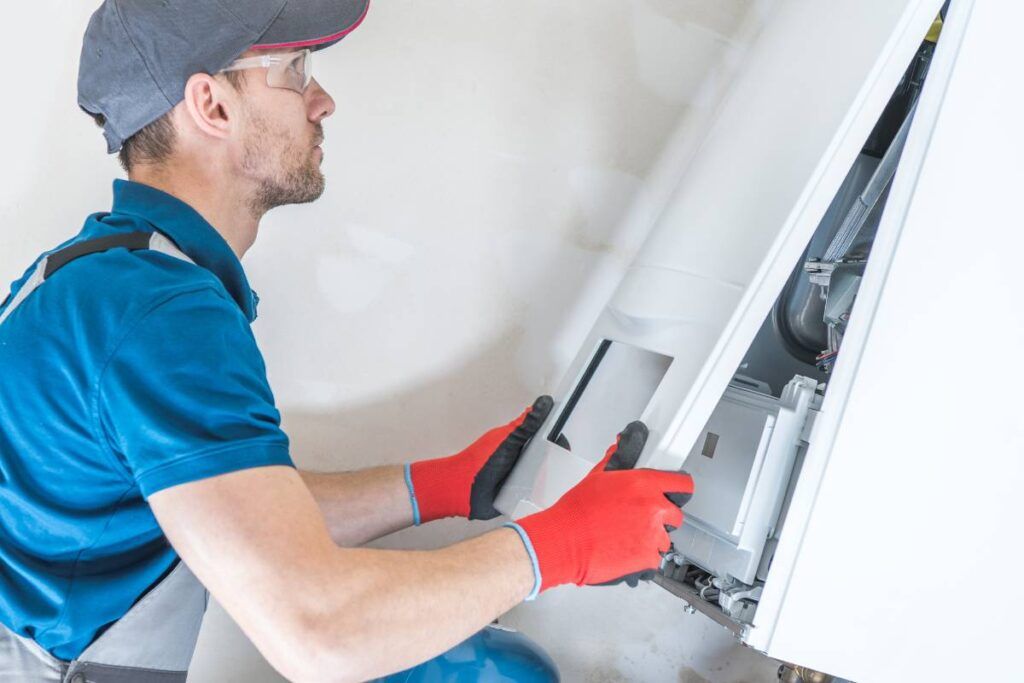
Check out our list of top-handpicked products for all your electrical, appliance, and HVAC system needs to keep your home running smoothly.
This post includes some affiliate links.How does the furnace work?
When the indoor temperature drops below the thermostat’s set temperature, the thermostat will signal the control board inside the furnace to start the heating cycle.
The unit starts by turning on the flame switch, opening the gas valve, and turning the draft fan for combustion.
The combustion warms the heat exchanger.
The flue gas inside the exchanger will release outside the exhaust pipe.
After that, the blower fan will blow cool air from inside your house past the exchanger.
From here, the air will absorb the heat forced throughout your house by the ventilation system.
That is how the furnace spreads the warm air.
What type of furnace do you own?
Before you discover the reasons behind a leaking furnace, you must know the type of your furnace.
The easiest way to find out is by checking the exhaust pipe.
If the line is white plastic PVC, you have a high-efficiency furnace. Since they generate condensation, leakage chances are more here.
If you have metal exhaust pipes, you have the standard non-high-efficiency furnace. It does not generate any condensation.
Where does the water come from in the furnace?
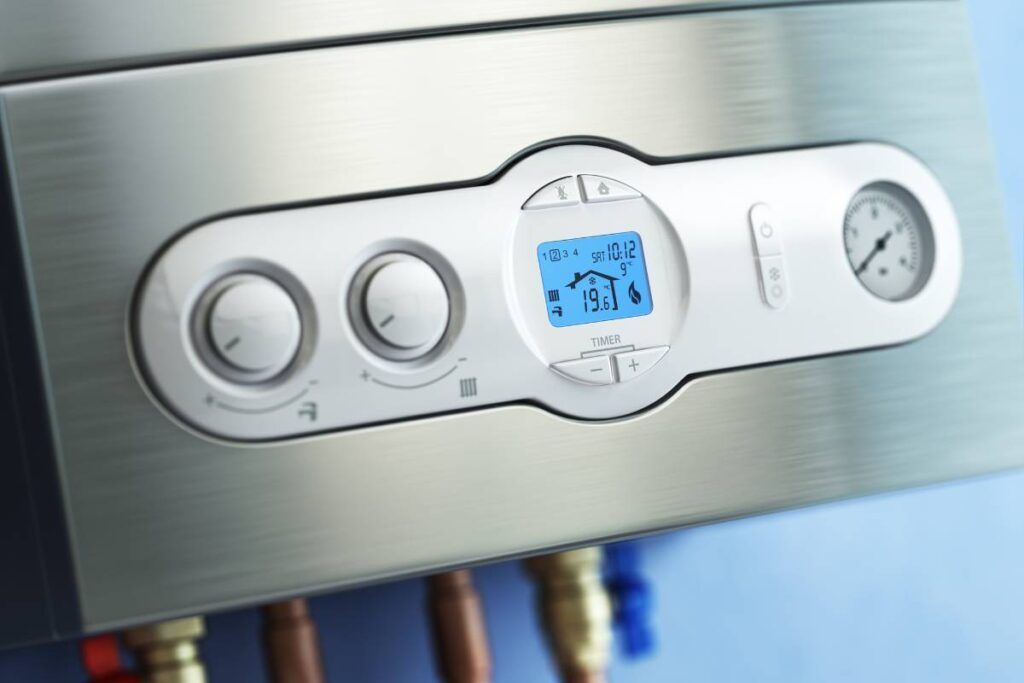
Not all furnaces will produce water.
The high-efficiency furnaces will produce water due to condensation.
The condensation increases because of the second heat exchanger.
That is why high-efficiency furnaces are also called condensing furnaces.
Conventional furnaces do not produce water and are therefore called non-high efficiency furnaces.
Once the burning gas goes out of the primary heat exchanger, it reaches the second exchanger.
The exhaust and flue pipe undergo another heat exchange in the second exchanger.
These exchanges make water vapor.
When the water changes from vapor to liquid, more heat is released in the second heat exchanger, making the unit work more efficiently.
From that point, the condensation is drained to the condensate pump or floor drain.
Why do high-efficiency furnaces leak water?
The following reasons are responsible for high-efficiency furnaces leaking water:
1. Leaked or clogged condensate pipes
High-efficiency furnaces generate enough condensation due to the heat exchanger process.
When the exchanger runs properly, the furnace will drain the condensation through the condensate line and drain trap.
If the condensate lines have leakage or clogging, the water will leak around your furnace because it has nowhere to go.
The water will back up and leak out of the furnace.
You can reopen the lines and clean them by pouring hot water or vacuuming them.
If the pipe is broken, it cannot hold the water and start leaking. You need to replace it with the help of HVAC experts.
2. Mechanical problems in the condensate pump
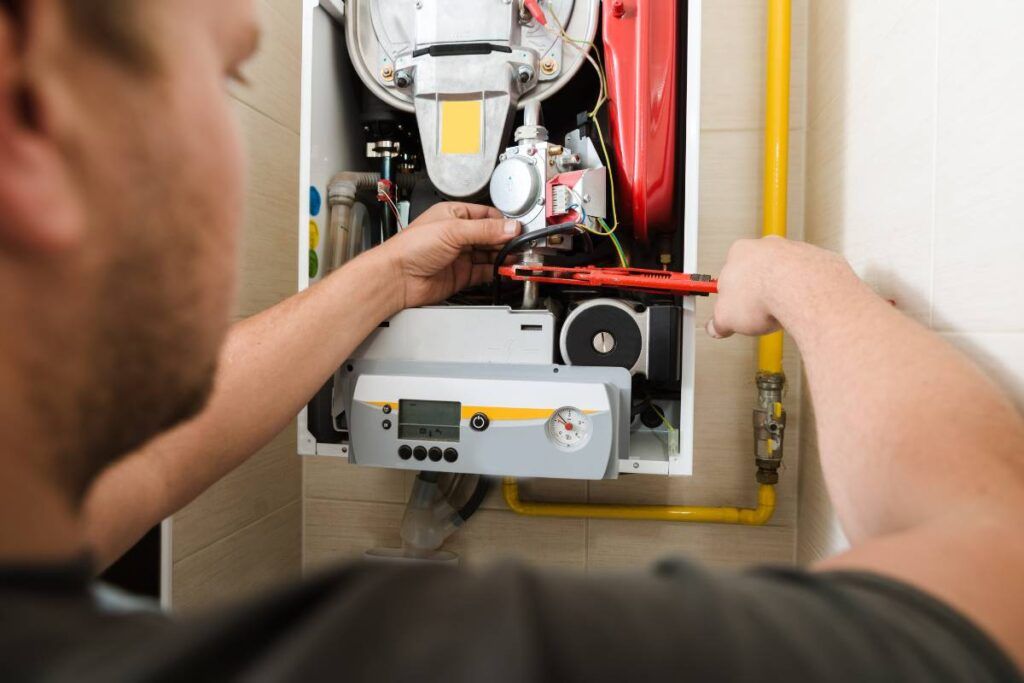
The condensate pump pushes the water through the condensate lines and away from your furnace.
If the furnace is installed in the basement, the drain pipes will be below the surface level, and the water will pump out.
So, the pump will pump out the water that drains into the pump tank through the hose and out of the outdoor’s drain line.
These pumps can malfunction due to mechanical issues, like jamming or damage, causing leakages.
The pump and the drain lines will overflow and flow the water back into the furnace and your floor.
Improper installation of the pump can cause leakages.
You must call an HVAC expert to inspect the pump and resolve the problem. Your pump may require replacement or repair.
3. Leaked condensate drain line
When the water needs to exit, it should pass through the condensate drain line.
The water will leak around the furnace when the connection gets cracked or has holes.
The condensing furnaces have a drain vent made of PVC.
The vent gets disconnected due to cracks or holes. As a result, the water will escape from that crack and leak from your unit.
A clogged drain line will take the condensation back to your unit and leak over the floor.
Problems in condensate drain lines are very common for high-efficiency furnaces.
Another problem is a rusted condensate pan. It happens when the pan is very old.
You must call a plumber or HVAC expert to replace the drain lines.
To clean the drain lines:
- Turn off your furnace.
- Find the condensate pan and drain the water with the duster.
- Clean the pan and the pan house with soapy water.
- Find the drain’s outside outlet and clear the clogs with the help of the Sink Snake Drain Cleaner.
- Wash the drain with hot water, vinegar, or hydrogen peroxide, and a drop of dishwashing soap to clear the remaining dirt.
If you cannot do it yourself, hire an HVAC expert.
4. Clogged condensate trap
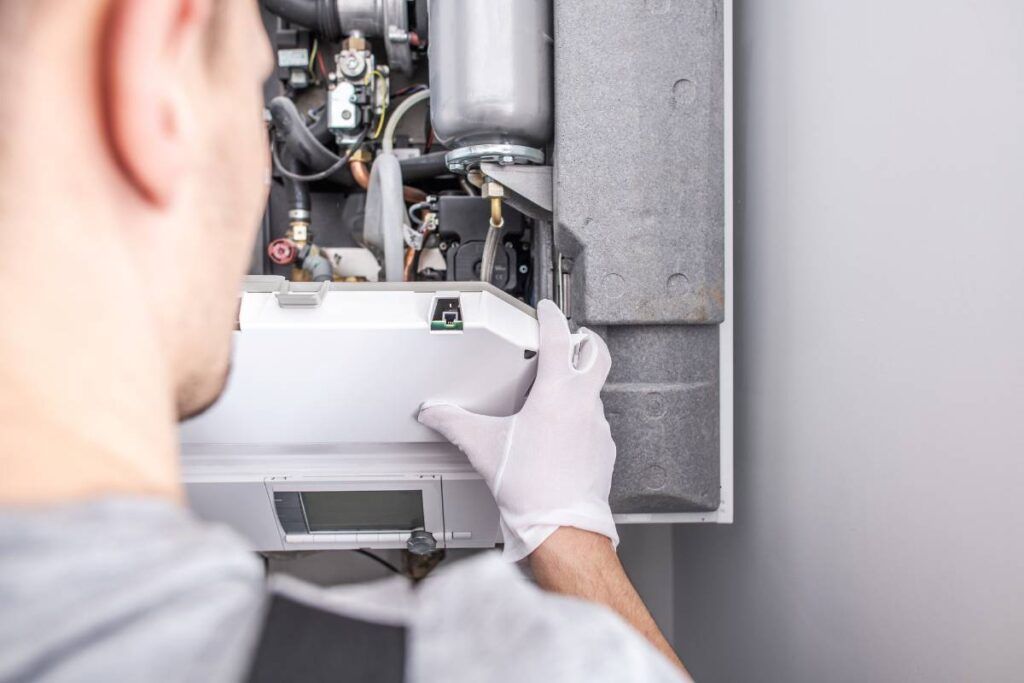
A clogged condensate trap also will take the water back to the furnace and end up leaking and overflowing around the furnace.
However, all high-efficiency furnaces do not have condensate traps.
Clean the trap by hiring an HVAC professional.
5. Leaked inducer assembly
The condensation goes down to the exhaust pipe through the condenser drain hose and then to the inducer.
If the inducer assembly is cracked, the water will leak out of the furnace.
Hire an HVAC expert to get it repaired or replaced.
Why do conventional furnaces leak water?
The high-efficiency furnaces are more prone to water leakage due to their condensation.
But that does not mean that the standard non-high-efficiency furnaces will not leak.
Here are the major reasons behind a conventional furnace leaking water:
6. The metal exhaust creates condensation.
Furnaces having an AFUE rating below 90 are considered conventional furnaces.
You can differentiate the two types with the pipes. Conventional furnaces have metal exhaust pipes.
These pipes take the gasses generated in the combustion process through the metal exhaust pipe and then away from your house when the gasses are hot.
When the venting pipe is improperly installed, has blockages, or the size does not match your furnace, the gasses will remain trapped by too much air.
Once they cool down, there will be condensation, and the furnace will leak water.
You must check the exhaust vent and look for clogs, disjoints, and bad joints.
It would be best if you repaired them to make a clear path for the gasses to release.
Here also you need an expert to deal with the matter, especially if there is any crack.
7. Leaking AC unit

When you live in a mild climate, you must use both the air conditioner and the furnace.
When your air conditioner functions, the condensation pan fills up too much with water over time. As a result, some water will drip into the furnace.
It may look like a furnace leaking water, but the problem could be simply an overflowing condensation pan.
When this happens, you must empty the pan or call an HVAC professional to fix the problem.
Other reasons behind a leaky air conditioner are:
Damaged drain pan
Clogged drain line
It may seem like your furnace is leaking, but it is the air conditioner.
8. Failed condensate pump
A condensate pump helps to drain the condensation from the HVAC system.
If your furnace and air conditioner share the same pump, there could be chances of leakage if the pump has too much moisture.
The water will overflow and leak around both units.
9. Frozen coil

When a furnace leaks in the winter, it is the frozen coils from the air conditioner.
When the ice on the coil starts melting, the drain pan will overflow, and some of the water will pass to the furnace.
As a result, you will feel that the furnace is leaking water.
There are several reasons behind a frozen coil, for example:
- Dirty air filter: A dirty filter blocks the airflow. Without enough warm air, the coil will freeze. Either replace the filter or wash it every 3 to 4 months.
- Closed or blocked vents: Blocked vents, too, will block the airflow and freeze the coil, leading to leakages. Keep the vents open and clear.
- Refrigerant leak: Refrigerant fluid releases cool air and makes your room comfortable in the summer. If the fluid level drops, the system cannot release hot air, freezing the evaporator coil. You need an HVAC expert to repair or replace the refrigerant tank.
Other furnaces behind leaking water
Despite these reasons, there are some other that could happen with all types of furnaces:
10. Dirty air filter

A dirty air filter in the furnace blocks adequate airflow.
As a result, the furnace will overwork to give you the desired heat and overheat.
Your furnace will not be able to run for a very long time and will end up with an explosion.
However, a dirty air filter does not directly cause water leakage. It will only happen if your furnace and air conditioner share the same ductwork.
Since most air conditioners have evaporator coils above the furnace, a dirty air filter will restrict the airflow, freezing the temperatures and accumulating moisture.
When the air conditioner is off, the ice will melt and flow over or below the furnace, especially if the condensate pan is full.
You can either clean the filter and put it back or replace it with a new one. Do this every 3 to 4 months.
Filterbuy 20x20x1 Air Filter MERV 8 Dust Defense (4-pack), Pleated HVAC AC Furnace Air Filters Replacement from amazon is a good choice for your furnace air filter.
Another is Filtrete 16x25x1, AC Furnace Air filter, Clean Living Basic Duct, 6-Pack.
If the leakage is not solved by changing the filters, there might be another reason for which you need an HVAC expert’s help to figure it out.
11. Problem with heat exchanger
Heat exchangers are an important part of the furnace and combustion.
The exchanger is a metal shield that prevents the exhaust gas of the combustion process from entering the ductwork.
Once the heat exchanger heats up, the metal will expand and cool.
It will again contract to return to its shape at room temperature.
Over time, the constant usage will make the heat exchanger wear out and crack.
Due to the crack, the furnace will leak water.
This water was supposed to drain through the condensate drain as an alternative path out of the unit.
Additionally, the carbon monoxide will enter and circulate your house, which can be quite life-threatening.
All the furnaces have a heat exchanger, but the high-efficiency units have two heat exchangers for the condensation to transfer from vapor to liquid and generate more heat.
Both exchangers will require maintenance.
Call an HVAC expert to repair or replace the heat exchanger.
Other reasons
The reasons explained above are some of the major causes.
Except for these, some other causes could lead to water leakage in your furnace, no matter the type.
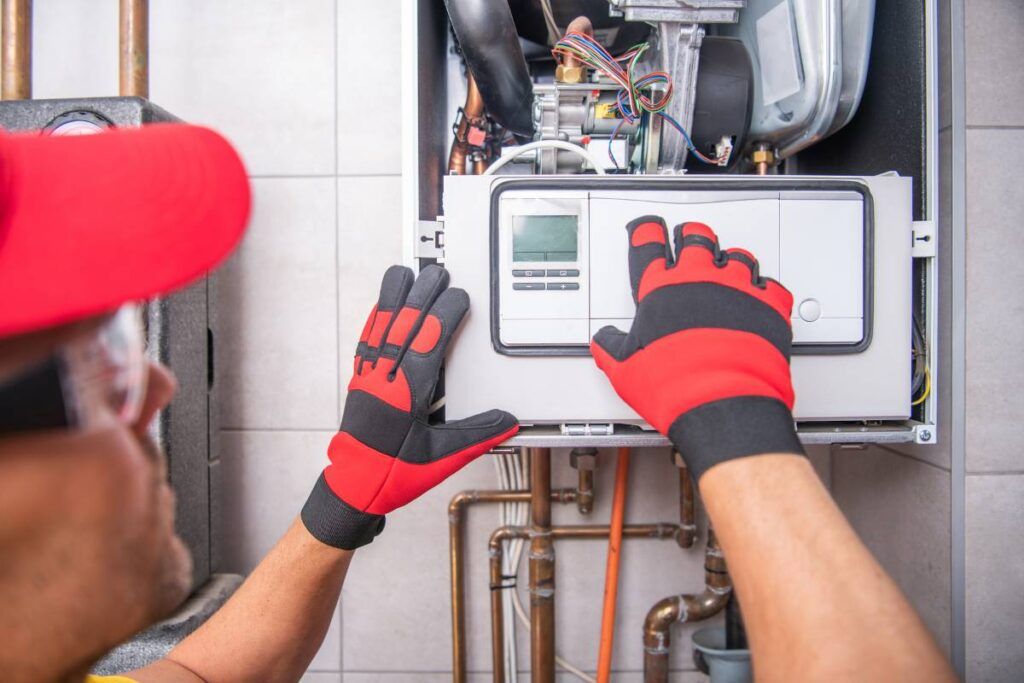
12. Leaking humidifier
To fight the excessive dryness in the winter, some house owners install humidifiers in the heating system.
The moisture will go through the humidifier every time.
So, if it gets clogged or starts leaking, the furnace will look like it is leaking water.
A dirty or clogged humidifier pad will also trap moisture and alter the indoor air.
Bacteria and mold can build up inside the house and harm you and your family.
The reasons behind a leaking humidifier are:
- Clogged water panel
- Clogged humidifier drain line
- Broken drain line
- Faulty solenoid valve
- High water pressure, above 125psi
If the humidifier leaks:
- Check the water panel for blockage, as it can prevent the water from flowing out of the cabinet.
- Check the humidifier’s drainage and use a wire to clear the blockage.
- Call an expert to fix the broken drain line and faulty solenoid valve, and adjust the humidifier’s water pressure.
13. External leak draining near the furnace
If you find a puddle of water under your furnace, the reason is an external source and not your unit, for example:
- Basement furnaces have drainage and clean water pipes around them. If there is a plumbing leak in these pipes, water will flow under the furnace and appear as if it is leaking.
- Appliances like washing machines and facilities like sinks in the basement may have loose drain hoses and leaks, for which the furnace area gets flooded.
- Plumbing leakages will drip water if the furnace is in the attic and contains pipes above the ceiling. It may look like furnace leakage.
Since the reason is an external source, you do not have to do anything with the furnace.
Please find the right source and fix it yourself or call an HVAC professional.
Also check:
- Furnace Only Works After Reset: 9 Problem+Fix
- 15 Reasons Your Furnace Won’t Turn On (+Fix)
- 14 Reasons Your Furnace Won’t Turn Off (+Fix)
- 16 Reasons Your Furnace Is Not Heating (+Fix)
- 12 Reasons Your Furnace Is Blowing Cold Air (+Fix)
- 10 Reasons Why You Shouldn’t Run A Furnace Without A Filter
- 9 Reasons Your Furnace Is Short Cycling (+Fix)
- 11 Reasons Your Furnace Won’t Stay Lit (+Fix)
- 9 Reasons Why Your Furnace Shuts Off After 30 Seconds
Final thoughts
A leaking furnace will not only cause panic but will also cause extensive and costly damage to your unit and floor.
Whenever you find a leakage in your furnace, turn off the unit’s main switch and switches at the breaker box immediately.
Please find out the reason behind it.
All the reasons explained above are mostly the common reasons behind the leakage.
You can crosscheck these points to figure out the main problem.
Though you can solve some issues yourself, always call an HVAC expert to confirm and fix the problem if you have exhausted the simple solutions.
FAQs
How much will it cost to fix a leaking furnace?
The cost to fix the leaking furnaces depends on the type of reason and damage level.
It could be a minor problem like air filters or secondary heat exchangers or a serious issue like a leaking humidifier.
The cost can vary based on the location.
For a better pricing idea, contact a local technician to find the exact range for your region.
Reference: Wikipedia.

